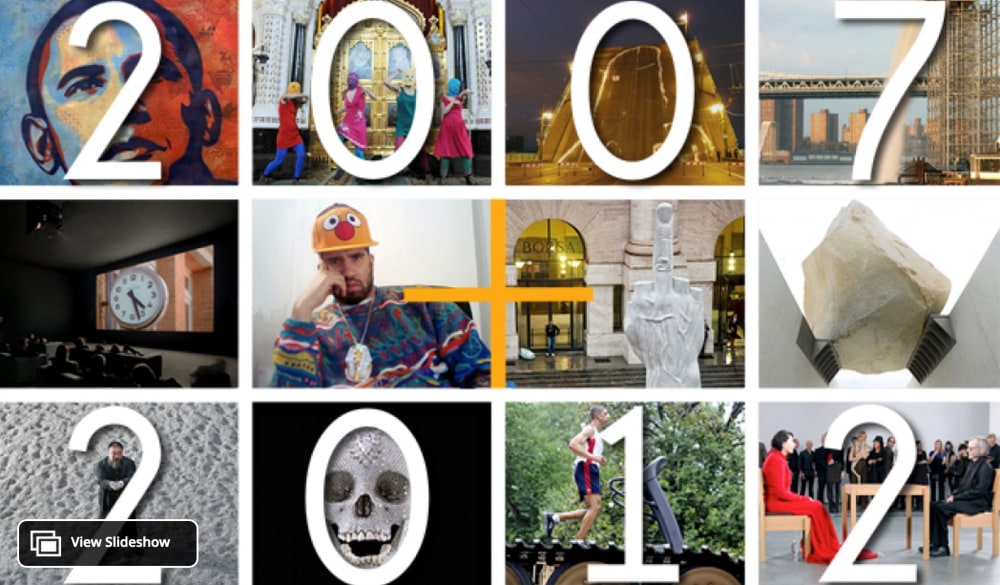
What are the most resonant works of art from the recent past? From among the thousands of individual works that pass through galleries and museums, which have affected the conversation in some significant way? Amid all of contemporary art's chaotic installations and ephemeral gestures, which images have some staying power? These are the questions that ARTINFO set out to answer with its list of "100 Most Iconic Artworks From the Last 5 Years."
How did we put together our ranking? First, we asked a broad group of colleagues to submit their nominations for artworks, from 2007 or later, that they considered to be in some way "iconic." Then we asked members of our staff and a few distinguished outsiders to give the works on the resulting list a score of 1 to 10. Adding our scores together, we came up with a ranked list of 100 artworks from the last half-decade.
Contributing to our ranking were Ben Davis (art editor, ARTINFO), Daniel Kunitz (editor-in-chief, Modern Painters), Coline Milliard (editor, ARTINFO UK), Madeleine O'Dea (editor, ARTINFO China), Jen Graves (critic, The Stranger), Walter Robinson (critic/editor, Art-Rite, Artnet Magazine), Martha Schwendener (critic, New York Times, Village Voice), and Christian Viveros-Faune (critic, ArtReview, Village Voice).
What do we learn from this exercise? Well, for one thing, despite all the chatter about the triumph of the art market, it is actually not necesarily the center of the action here. Christian Marclay's "The Clock" was produced for a gallery, as was Damien Hirst's "For the Love of God" and Urs Fischer's "You." But a great number of the memorable works on our list were conceived for museum shows, biennials, or as public art works of various kinds. Street art, or works that found an audience through relatively unconventional channels, like Jon Rafman's "9 Eyes of Google Street View" (which gained notoriety as a photo essay on Art Fag City) or William Powhida's "How the New Museum Committed Suicide With Banality" (which took fire as a cover for the Brooklyn Rail), were as likely, if not more likely, to leave a mark as conventional gallery fare.
Another thing that stands out in the list is the high number of works that are participatory mass spectacles, and the low number that are old-fashioned painting. It's not that contemporary painting is incapable of creating an "iconic" image: one work that many of our contributors suggested as being "iconic" was Luc Tuymans's "The Secretary of State" — but that was from 2005, outside of our date range. Nevertheless, to speak of general trends, it looks like the artist as image-maker is out; the artist as stage manager is in.
It also seems to help to penetrate the collective mind if you draw on the energy of politics in some way — though that way can vary greatly, from the straight-forward idealism of Shepard Fairey's "HOPE" poster, to the gonzo activism of Voina's "A Dick Captured by the FSB." Works as diverse as Ai Weiwei's "Remembering" and Paul Chan's "Waiting for Godot in New Orleans" become particularly evocative in the way that they resonate with their social background (the Chinese artist's own outspoken politics or the recent tragedy of Hurricane Katrina in New Orleans, respectively).
Finally, more than one "iconic" artwork on our list has become resonant in its failure as much as its success, from Christoph Büchel's "Training Ground for Democracy," whose vast ambition famously resulted in it never being completed, to Richard Prince's "Canal Zone," which has become a symbol, in a way, of the battles over the use of appropriated imagery — hardly its intended effect. At any rate, it seems clear that "iconic" doesn't necessarily mean "successful," though it does mean that the work in question throws off some kind of charge that is bound to have larger effects.
Here it is then, ARTINFO's "100 Most Iconic Artworks of the Last 5 Years" (to see our illustrated commentary on the Top 25 Most Iconic Artworks, click on the slide show):
2) Marina Abramovic, "The Artist Is Present," 2010